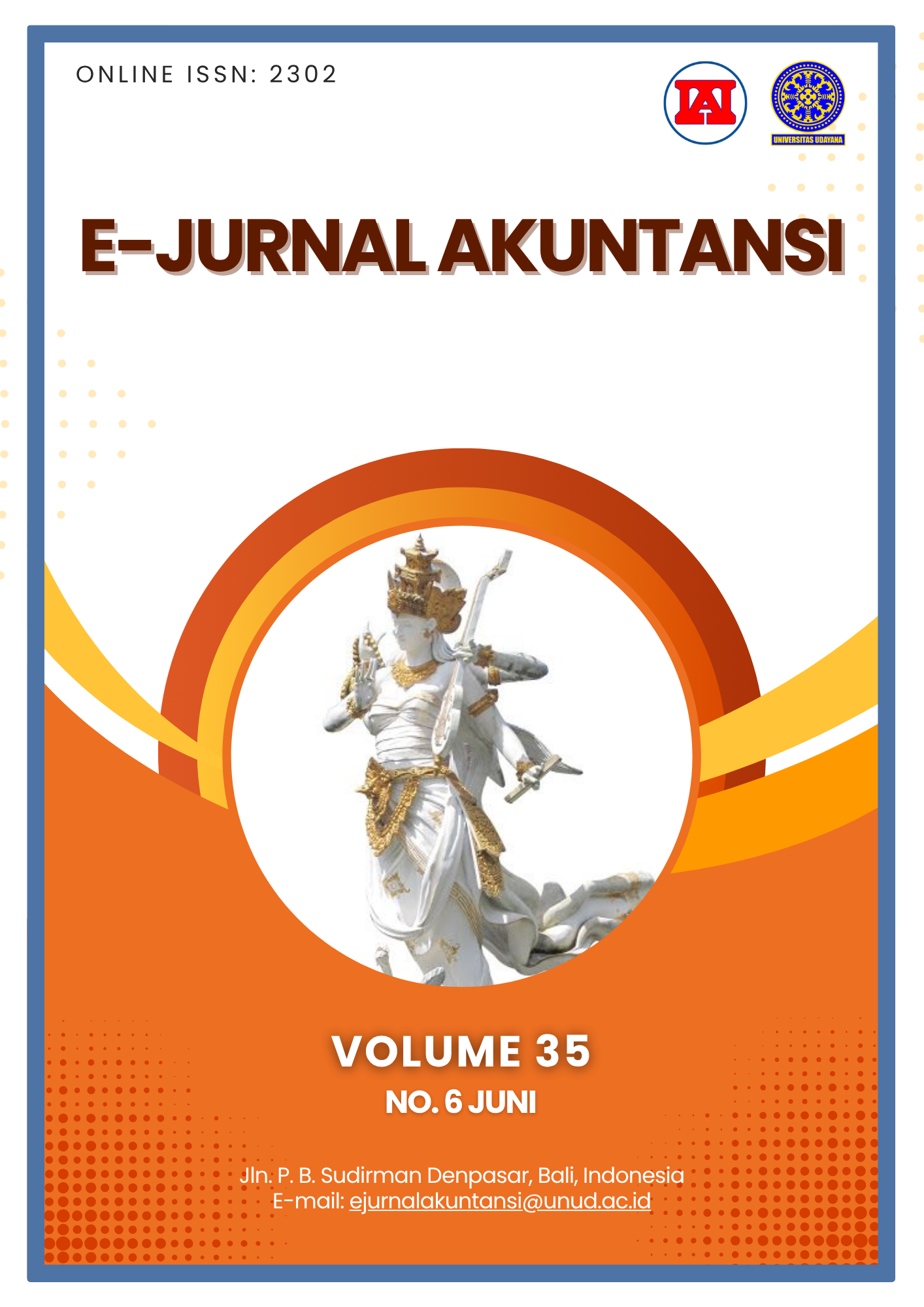Analysis of the Three Lines Model in Risk Management of Village Fund Procurement in East Kalimantan
Abstract
The procurement of goods and services (PBJ) funded by the Village Fund often faces high risks, including delays in implementation, nonconformity to specifications, and potential irregularities. These risks are largely due to weak internal control systems and a low understanding of risk management among village officials. This study examines how applying the Three-Line Model can improve risk management in XYZ Village's procurement process. A qualitative case study approach was employed, utilizing data collection techniques such as document review and semi-structured interviews with nine informants from the village government, the Department of Rural Development and Social Welfare (DPMDes), and the Regional Inspectorate. Data were collected from January to March 2025 and analyzed thematically using source triangulation. The results revealed that the three lines were not functioning optimally and lacked support from an integrated risk management system. This research empirically contributes to strengthening Village Fund governance by integratting risk management practices into the Three Lines Model framework.
Keywords: Three Lines Model; Risk Management; Procurement of Goods and Services; Village Fund.
Downloads
References
Asbeni, M., & Sunardi. (2018). Manajemen Risiko Pengelolaan Keuangan Desa. Prosiding Seminar Nasional Pengembangan Teknologi Pertanian VII Polinela. https://jurnal.polinela.ac.id/PROSIDING/article/view/1147/775
Badan Pengawasan Keuangan dan Pembangunan. (2021). Peraturan BPKP Nomor 4 Tahun 2021 tentang Pedoman Manajemen Risiko Instansi Pemerintah. Jakarta: BPKP.
Bantleon, U., d’Arcy, A., Eulerich, M., & Ratzinger-Sakel, N. V. S. (2021). Coordination challenges in implementing the three lines of defense model. International Journal of Auditing.
Campbell, R., Goodman-Williams, R., Feeney, H., & Fehler-Cabral, G. (2020). Assessing Triangulation Across Methodologies, Methods, and Stakeholder Groups: The Joys, Woes, and Politics of Interpreting Convergent and Divergent Data. American Journal of Evaluation, 41(1), 125–144. https://doi.org/10.1177/1098214018804195
Creswell, J. W., & Poth, C. N. (2018). Qualitative Inquiry and Research Design (4th ed.). [https://books.google.co.id/books?id=DLbBDQAAQBAJ&printsec=frontcove
Dilaga, O. S. (2018). Perancangan manajemen risiko terhadap pengelolaan keuangan desa: Studi kasus di Desa Barabali, Kabupaten Lombok Tengah (Tesis Magister, Universitas Indonesia).
Ellet, W. (2018). The Case Study Handbook - A student’s guide. In Harvard Business Publishing.
Ginting, A. H., Widianingsih, I., Mulyawan, R., & Nurasa, H. (2023). Village government’s risk management and village fund administration in Indonesia. Sustainability, 15(24), Article 16706. https://doi.org/10.3390/su152416706
Haryanto, B. (2021). Governance dalam pengelolaan Dana Desa. Jurnal Administrasi Desa, 14(2), 45-58.
Hendrik, W. S. (2023). Tata Kelola Keuangan Desa di Kalurahan Wedomartani dalam Perspektif Governance. Sekolah Tinggi Pembangunan Masyarakat Desa “APMD”, Yogyakarta.
Institute of Internal Auditors. (2020). The IIA’s three lines model: An update of the three lines of defense. https://www.theiia.org
International Organization for Standardization. (2018). ISO 31000:2018 – Risk management – Guidelines. Geneva: International Organization for Standardization.
INTOSAI. (2022). Three lines of defense: Implementation guidance for the public sector. International Organization of Supreme Audit Institutions. https://www.intosai.org
Kementerian Dalam Negeri Republik Indonesia. (2018). Permendagri No. 20 Tahun 2018 tentang Pedoman Pengelolaan Dana Desa. Kementerian Dalam Negeri Republik Indonesia. http://binapemdes.kemendagri.go.id/uploads/gallery/permendagri_no_20_TH_20181.pdf
Kin, R. K. (2018). Case Study Research and Application Design and Methods (6th ed.). SAGE Publications Ltd.
Lembaga Kebijakan Pengadaan Barang/Jasa Pemerintah. (2019). Peraturan Lembaga Kebijakan Pengadaan Barang/Jasa Pemerintah Nomor 12 Tahun 2019 tentang Pedoman Penyusunan Tata Cara Pengadaan Barang/Jasa di Desa. https://jdih.lkpp.go.id/regulation/peraturan-lkpp/peraturan-lkpp-nomor-12-tahun-2019
Muslih, M., & Umar, H. (2021). Risk management issues of village fund management in Kedung Pengawas Village. In Advances in Social Science, Education and Humanities Research, 560, 54–57. https://doi.org/10.2991/assehr.k.210525.022
Organisation for Economic Co-operation and Development (OECD). (2021). Public Governance Risk Management Framework: Strengthening Government Resilience through Strategic Risk Management. Paris: OECD Publishing.
Organisation for Economic Co-operation and Development. (2021). Public governance risk management framework: Strengthening government resilience through strategic risk management. https://www.oecd.org/governance
Pandey, S. C., & Patnaik, S. (2020). Case Study Research. In R. N. Subudhi & S. Mishra (Eds.), Methodological Issues in Management Research: Advances, Challenges, and the Way Ahead (Issues 163–179). Emerald Publishing Limited. https://doi.org/10.1108/978-1-78973-973-220191011
Pemerintah Indonesia. (2008). Peraturan Pemerintah Nomor 60 Tahun 2008 tentang Sistem Pengendalian Intern Pemerintah (SPIP). Jakarta: Kementerian Sekretariat Negara.
Ruslin, Mashuri, S., Abdul R, M. S., Alhabsyi, F., & Syam, H. (2022). Semi- structured Interview: A Methodological Reflection on the Development of a Qualitative Research Instrument in Educational Studies. Journal of Research & Method in Education, 12(1), 22–29. https://doi.org/10.9790/7388- 1201052229
Simangunsong, F., & Mario, A. I. (2018). Study on possibility of applying risk management in village fund management in Landak Regency Indonesia. Open Journal of Social Sciences, 6(9), 271–297. https://doi.org/10.4236/jss.2018.69019
Suharyo, S. (2020). Akuntabilitas dalam Pengelolaan Dana Desa: Tantangan dan Solusi. Jurnal Keuangan Daerah, 9(1), 29-41.
Susan, N., & Budirahayu, T. (2017). Village government capacity in the implementation of village law No. 6 of 2015 in Indonesia. Sustainable Future for Human Security: Society, Cities, and Governance.
Undang-Undang Republik Indonesia. (2014). Undang-Undang Republik Indonesia Nomor 6 Tahun 2014 tentang Desa. Jakarta: Kementerian Sekretariat Negara
Widyagama University. (2021). Pengelolaan Keuangan Desa berdasarkan UU No. 6 Tahun 2014. Call for Papers WNCEB 2021, 609–612.
Wulandari, M., & Idayati, F. (2024). Dampak Pengelolaan Dana Desa dalam Pembangunan Infrastruktur Desa dan Pemberdayaan Masyarakat. Jurnal Ilmu dan Riset Akuntansi, 13(8), 1–10. https://jurnalmahasiswa.stiesia.ac.id/index.php/jira/article/view/6049/6102

This work is licensed under a Creative Commons Attribution-ShareAlike 4.0 International License.

















